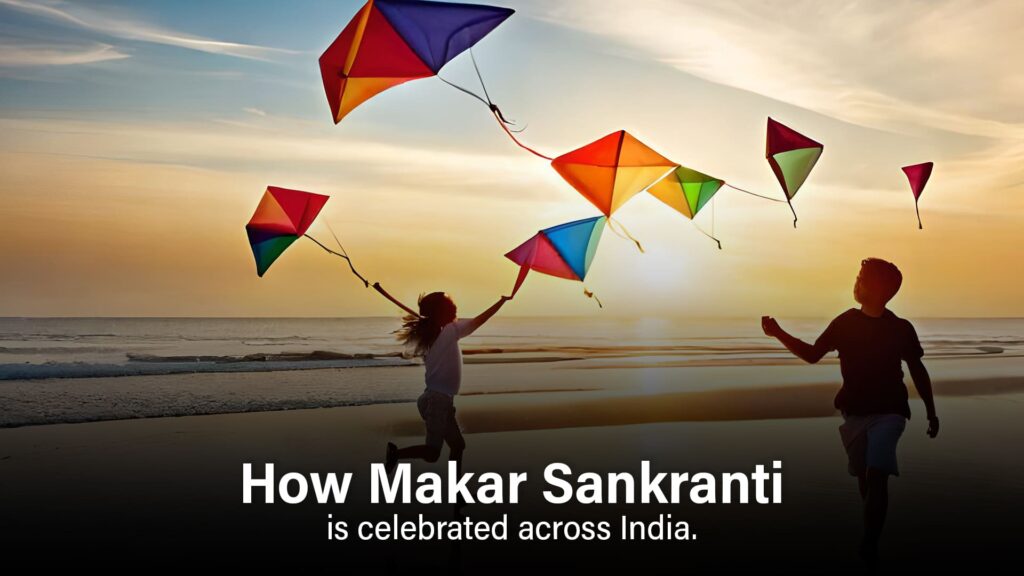Makar Sankranti, celebrated in January, is one of India’s most vibrant and culturally significant festivals. Also known as the ‘festival of kites,’ it marks the sun’s transition into the zodiac sign of Capricorn (Makara). Falling on January 14th or 15th, the festival is a harbinger of longer days and the onset of warmer temperatures.
Makar Sankranti holds immense cultural and religious significance in various parts of India. The festival symbolizes the end of winter and the beginning of the harvest season, emphasizing the importance of nature’s cycles in agrarian societies. It is a time to express gratitude for the bountiful harvest and seek blessings for a prosperous future.
The festival is a regional celebration and a pan-Indian phenomenon, observed with unique customs and traditions across different states. Let’s delve into the diverse celebrations that make Makar Sankranti a kaleidoscope of cultural richness.
States Celebrate Makar Sankranti
Makar Sankranti is celebrated across various states, including Maharashtra, Karnataka, Andhra Pradesh, and West Bengal. Each state adds its own unique flavors to the festival, making it a diverse and colorful panorama of cultural expressions.
As January unfolds, the landscape of India transforms into a cultural mosaic, and Makar Sankranti stands as a testament to the country’s rich heritage and unity in diversity. The festival not only bridges geographical boundaries but also serves as a reminder of the interconnectedness between nature, agriculture, and the diverse cultures that thrive in the vast tapestry of India.
States You Should Travel for Makar Sankranti
Uttar Pradesh
Makar Sankranti witnesses grand celebrations in Uttar Pradesh, particularly in cities like Varanasi and Allahabad. The holy city of Varanasi becomes a hub for spiritual activities, with pilgrims taking ritual baths in the Ganges. The skies come alive with colorful kites, and the sweet aroma of traditional delicacies fills the air.
Gujarat
Gujarat is renowned for its extravagant Uttarayan Kite Festival during Makar Sankranti. The skies above cities like Ahmedabad and Vadodara transform into a canvas of vibrant kites, showcasing the state’s enthusiasm for this ancient tradition. The International Kite Festival in Ahmedabad attracts kite enthusiasts from around the world.
Tamil Nadu
Tamil Nadu celebrates the festival as Pongal, a four-day harvest festival. The streets come alive with kolam decorations, and families gather to cook the traditional Pongal dish. The festival is a visual treat with elaborate rangoli designs and community bonfires symbolizing the end of the winter solstice.
Assam
Bhogali Bihu, the Assamese celebration of Makar Sankranti, involves feasting, traditional dances like Bihu, and lighting of bonfires. The state embraces the festival with cultural enthusiasm, reflecting the deep connection between the rural lifestyle and the festivities.
Changing Trends in Kite Festivals
While rooted in tradition, Makar Sankranti’s celebration has evolved over time, particularly in kite flying. Modern influences have led to changes in kite designs and materials. Kite enthusiasts now showcase innovative designs, incorporating technology and artistic creativity. The skies are adorned with traditional geometric kites and intricate designs representing contemporary themes.
The advent of social media has played a pivotal role in promoting regional celebrations of Makar Sankranti. Communities across states now share their unique customs and festivities, fostering a sense of unity among diverse cultural practices. From online kite-flying challenges to virtual cooking sessions featuring traditional sweets, social media platforms have become a virtual stage for the grandeur of Makar Sankranti.
Fusion of Traditional and Contemporary Elements
Makar Sankranti celebrations today often showcase a blend of traditional and contemporary elements. Cultural events, folk performances, and music concerts contribute to the festive atmosphere, appealing to both younger generations and those seeking a modern twist to age-old traditions. This fusion reflects the dynamic nature of Indian culture and the festival’s ability to adapt to changing times.
COVID Measures to Take on Sankranti
Safe Gatherings
Given the ongoing concerns related to the COVID-19 pandemic, it’s essential to prioritize safety during Makar Sankranti celebrations. Opt for smaller, intimate gatherings with close family and friends to reduce the risk of virus transmission. Consider virtual celebrations for those who cannot join in person.
Masking and Sanitization
Encourage using masks and hand sanitizers at gatherings, especially in crowded areas such as kite-flying events. Emphasize the importance of personal hygiene to mitigate the spread of the virus and ensure a safe environment for all participants.
Outdoor Celebrations
Where possible, opt for outdoor celebrations to minimize the risk of indoor transmission. Open spaces provide better ventilation and allow for social distancing measures to be more effectively implemented. Consider organizing kite-flying events, picnics, or other activities in spacious areas.
Virtual Connect for Distant Celebrations
For those unable to travel or join in person, leverage technology to stay connected virtually. Arrange video calls, virtual events, or live-streaming of local celebrations to ensure everyone can participate in the festivities while staying safe.
Adherence to Local Guidelines
Stay informed about and adhere to local COVID-19 guidelines and regulations. Different regions may have varying restrictions and safety measures in place. Prioritize the well-being of yourself and others by following these guidelines during Makar Sankranti celebrations.
As January unfolds, the celebration of Makar Sankranti transcends regional boundaries, uniting the nation in a joyous expression of gratitude and hope. From the colorful kites soaring high above to the traditional sweets shared among families, Makar Sankranti embodies the spirit of India’s cultural richness. As the festival continues to evolve, it remains a testament to the resilience of traditions, the unity in diversity, and the enduring connection between humanity and the natural world.

